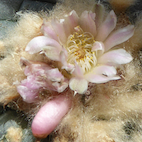-
Content count
1,221 -
Joined
-
Last visited
-
Days Won
20
About trucha
-
Rank
I work for the plants.
Profile Information
-
Gender
Male
-
Country
USA
Previous Fields
-
Climate or location
7
Recent Profile Visitors
4,828 profile views
-
Maybe. Cacti are not known for betacarbolines (even though traces were claimed to have been observed in one recent paper, said paper did not engage in an isolation or structural proof). It is more common for cyclization of phenethylamines in cacti to lead to isoquinoliones. Some of which are known MAOIs. Peyote was fermented also, in ancient Mexico, but the result was described as a vinagre rather than being ethanolic.
-

Trichocereus pachanoi reclassified as macrogonus var pachanoi
trucha replied to saguaro's topic in Cacti & Succulents
No DNA barcode but there has been ongoing genetics work in this area for a few years now. This one is easy enough to look up. Google Boris Schlumberger & Renner [MOLECULAR PHYLOGENETICS OF ECHINOPSIS (CACTACEAE): POLYPHYLY AT ALL LEVELS AND CONVERGENT EVOLUTION OF POLLINATION MODES AND GROWTH FORMS] and also Albesiano & Kiesling [Identity And Neotypification Of Cereus Macrogonus, The Type Species Of The Genus Trichocereus (Cactaceae)] and Albesiano & Terezas [Cladistic Analysis Of Trichocereus (Cactaceae: Cactoideae: Trichocereeae) Based On Morphological DATA And Chloroplast Dna Sequences] However Albesiano's peruvianus came from a plant someone had collected in Bolivia, submitted at La Paz as a lageniformis and was then renamed peruvianus by Albesiano. They appear to have *looked at* Britton & Rose's sad collection sheet but did not include any Peruvian material in their actual analysis of peruvianus (among other problems such as declaring a plant someone had collected from near Tarma Peru to be both a bona fide macrogonus and their Neotype) so Albesiano's work is also easily attacked. David Hunt accepted their proposed revision anyway and even restored Trichocereus as the genus for these plants but since his death Echinopsis is again regarded to be accepted genus name (despite there being no question that it is polyphyletic). More work is ongoing by other workers. Genetics work is getting affordable. -
The fundamentalist Christian element is an artifact of the formation of reservations and the ten member Board of Indian Commissioners created by Ulysses Grant when he was president. Grant wanted all ten to be Quakers but other Protestant groups protested so oversight of the reservations was divided among the "Reformed Protestants". Due to the intense anti-papal sentiment of the day the Catholics were excluded on the first round and had to fight to eventually be granted oversight of a reservation. People can view the conversion as a veneer intended to cover and protect their use of peyote but I suggest that is not entirely accurate. I would actually suggest most of the fundamentalist Christians are sincere in that belief. Keep in mind all indigenous religion, including the very existence of their medicine people, was made illegal in 1888. Conversion was not something people on reservations got to choose as failure to comply was punished by withholding food from them. That is a huge motivation. Similarly people had their children removed and re-educated in distant schools on how to be good Christians and productive citizens suitable to feed back into the great melting pot. The deliberate effort to destroy indigenous culture by forced acculturation was among the biggest crimes and travesties of US history. What a lot of people miss in this is that these reformers believed they were being helpful as a lot of other people would have preferred they were all completely exterminated.
-
Makes total sense from a Western perspective but it is actually a nonstarter despite the very rational sanity that exists in your suggestion. For the vastly largest part NAC members do not view or use mescaline or mescaline containing plants as their sacrament. They use peyote. That might sound like I am merely splitting hairs but San Pedro has different effects, a different taste and a different personality. This is a religious activity for them and it is not regarded to be a drug experience. For you and me such substitution would no doubt pose no problem as Western reductionism is valid in Western ideology. This subject goes far beyond what we are talking about there as a rather large portion of the NAC is still strongly opposed to cultivation even if done within the NAC itself due to their belief that it shows a lack of faith in the ability of the peyote to protect itself. Instead harvesting for users north of the border increased in Mexico. Thankfully this is now slowly in the process of changing or at least NAC people who do not object to cultivation have openly begun cultivation activities as of 7-8 years ago. It has been going on quietly for some time but I also know of one chapter which stopped growing around 12 years ago when their supplier threatened to cut them off of their peyote supply if they did not cease cultivating peyote. Cultivation within the NAC would likely be much more widespread if not for the pressure against it that became very vocal in the early 1990s. This is all an internal matter for the NAC to work through and resolve as no outsiders have the right or the wisdom to tell other people how to practice their religion. Spokespeople from the NAC have repeatedly stated to legislators and to the press that mescaline is not their medicine and San Pedro is not their medicine so have boxed themselves into a corner should their minds someday change. Only in the last several years have we heard claim being laid over them and that has been entirely in the context of decrim efforts and a desire to keep mescaline from being decriminalized. There has been a lot of effort directed at keeping not just peyote but mescaline out of DN proposals. It has in a growing number of cases been successful in omitting mescaline and any mescaline containing cacti and in others has only kept peyote and mescaline derived from peyote excluded. In far fewer instances peyote HAS been included in the decriminalization initiatives that were passed. One more bit of subtlety is that *only* the 'nondrug use' of peyote is viewed by DEA as having protection. Not only is there no guarantee that respect would be extended to the NAC for using other mescaline containing cacti or mescaline but since that would be based on recognizing they the same active drug, and therefore are drug use, it might actually go against them. Saying "peyote is not a drug" is more than just words for them, in DEA's eyes it is their legal defence for being able to use it in ceremony. One element to bear in mind is the NAC is not a homogenous organization in thought or beliefs. It is actually not an organization. It is a loose affiliation of around 170 chapters; each of which have their own charter and can write their own bylaws and membership rules. Most of them are formally incorporated. Many are fundamentalist Christians, some still have their original religion and are not Christianized and many are somewhere in between. Similarly many chapters strictly preclude others from participating (65 or so percent) and others welcome anyone who is sincere. This is easily missed if hearing the most vocal rhetoric appearing in the press. I know a very tiny number of NAC people who do use San Pedro. I know far more who absolutely reject it. I have never met any NAC member who would accept synthetic mescaline as a sacrament. There certainly may be someone out there but I have not met them and far more members would protest against the idea rather loudly. The discussions referenced at chacruna are generally about the concern for protecting peyote populations by insisting that only synthetic mescaline should be used for therapeutic applications rather than peyote or mescaline that has been extracted from peyote. There are at least five psychedelic start-ups based around the use of mescaline so that is a great idea. As was mentioned earlier, one can also find this notion being embraced in a number of the Decrim Nature initiatives. The thing which would go farthest to resolve the dilemma with the least complexity would be repealing the controlled substances act and also declaring peyote to be a federally listed endangered species. Congress gave all people in the USA who qualify for federal aid by virtue of being recognized as a member of any indigenous entity (group, tribe, pueblo, etcetera) the right to harvest, possess, transport, and consume peyote and to cultivate it in a regulated manner so adding that layer of protection to peyote would not affect NAC peyote access or use.
-
i don't know what that is which is being shown at the dream herbs site. Seeds are achenes. There is a drawing of one in the article at: https://cdnsciencepub.com/doi/full/10.1139/cjb-2021-0063 In general, achenes become ready to harvest when they dry and start to fall out. I'm betting your flowers looked like what is shown in that article?
-
One modification to that. *Eventually* the regrowth will equal the original crown. We just do not yet know how many years that will require. There is still a lot of work left to do. A valuable book exploring the central role of religious ideology in stimulating and supporting magical thinking was written by Weston LaBarre. The book the Ghost Dance is rather dense but well worth the time. It may be the best book ever written on the how and the why underlying the irrational phenomenon that is commonly referred to as crisis cult thinking. LaBarre's premise is that development of this type of ideation is most often fatal to the culture or group holding it (for example a Pacific island culture who's spiritual leader had a vision that the supply-bearing 'gods' who had been visiting them in shiny silver birds stopped coming because they are not happy with the islanders so they needed to kill their animals and not plant crops to regain the gods' sympathy -- obviously that did not turn out well) but sometimes circumstances allow its survival and it has then gone on to become one of the world's religions.
-
-
I am uncertain where this would best be posted but I anticipate some people may enjoy this interview by Joey Santore. https://podcasts.apple.com/gb/podcast/how-ancient-glaciers-affect-peyote-a-conversation/id1458563601?i=1000625578250
-
Finally some Bay area showings of Connie Littlefield's Better Living Through Chemistry Tickets for the June 15th Oakland screening have gone on sale at this link: http://www.renaissancerialto.com/Better%20Living.php There is also a Facebook page for the film: https://www.facebook.com/BetterLivingThroughChemistryTheShulginFilm and a web site for the film: https://betterlivingthroughchemistry.org/
-

Interesting paper that was brought to my attention
trucha replied to trucha's topic in Cacti & Succulents
The authors of that forensic journal article assumed a few things that are not true (bridgesii being a perfect example). It is common for people (including medical or scientific researchers) to somehow assume that any specimen of a given species which they encounter is going to follow what has been said about them in the literature. We already know that analytical results can vary wildly due to multiple factors. It is even more fascinating that they don't connect the dots and hear what is being said in the claims they want to dismiss rather than clinging to what is being extrapolated from a few lonely analytical data points. Rather than dismissal of what does not agree with their conclusions, this particular conflict should tell them that more work is merited. That newer paper adds some more weight to that line of thought. "Abuse" or "abused" are loaded words. In most cases what is meant is any use at all that is not approved of by the speaker. This largely comes from the same mindset as would refer to masturbation as self-abuse. -
https://zenodo.org/record/6409376#.YkzsKy1h3OS
-
The objection is to anyone other than them growing peyote; yet most of the NAC is opposed to cultivation itself. Similarly the comment about mescaline extraction only be allowed for ceremonial purposes omits the fact that no one extracts mescaline for the NAC to use in ceremony as they have always rejected mescaline as a sacrament. Much of what this says is actually untrue and their interpretation of the federal peyote law is not accurate. The amendment to RFRA granted the right to peyote to all people who qualify for federal aid by virtue of their group being recognized as "Indians". Which excludes any indigenous people who did not successfully enter into treaty negotiations. It was said to be protecting traditional culture yet very few of the modern peyote using groups used peyote a century ago and some began to use it only after the 1996 law went into place giving them the right. This is now a traditional practice for all of them but the suggestion that it has always been a traditional sacrament across North America north of Mexico is gaslighting. They also are increasingly objecting to San Pedro use which might be why there is a strange inclusion about peyote being used traditionally in South America. This is likely to be part of the opposition to Decriminalize Nature and its ongoing push to decriminalize psychedelics. A national policy like this might help prevent them repeating their efforts to oppose decrim in every city council meeting or state legislative action as has been the case. The current venue for this is a state referendum in Colorado. Peyote has been excluded from decrim in most places already due to this and San Pedro was also excluded in Santa Cruz after objections were raised about its use being culturally inappropriate. ALL peyote consumed by the NAC comes from the wild. A good bit of it is smuggled in from Mexico and has been for years. The NAC now estimates its membership at 600,000 so those 1 million or so buttons reported to be harvested and sold in Texas each year have not been going far.
-
It's worth reading carefully as there is a lot packed into it. https://chacruna.net/national-congress-american-indians-resolution-protect-peyote/
-
Yes. There were two movies made about him and there have been around half a dozen publications about him or his practice written by or involving Douglas Sharon. One of which was at least partially by Eduardo Calderon (Terapia de la Curanderia). The Spanish language version of that book includes content that somehow never made it into the English version so I would recommend that for anyone who reads Spanish.
-

"Lost Peyotes" and other Psychoactive or Medicinal Cacti
trucha replied to Teotzlcoatl's topic in Cacti & Succulents
It is a reagent test that shows the simple presence of alkaloids due to forming a precipitate. It is made from potassium iodide and bismuth subnitrate in an acidic solution or is available commercially. Concentration of alkaloids can be crudely estimated based on the turbidity if a person has much experience with using it. (Silicotungstic acid has been more commonly used for this same crude application in Australian work and appears to be a better choice.) It does not say what alkaloids are present but is used as a field screening (meaning it is done while a person is still in the field rather than after coming back home) to check if something is worth looking into more deeply. It also is commonly reported to fail with some alkaloids or to work for some people and not for other people. One recurrent element has been a low degree of rigor for people who really want to make a discovery and therefore push things into print prior to having enough facts. That has occurred in a couple of cases. Armatocereus laetus (aka pishicol) being one of them and Brasiliopuntia brasiliensis (aka tchai) being another. In both cases these most likely came about when an informant ran out of things to share with the ethnobotanist but as a friendly host did not want to disappoint them. There is no problem putting tentative and unproven claims into print but having openness to those turning out to be wrong is also important when doing so. When something fails to be supported in analysis or large animal bioassays the burden of proof falls on those who were making the claims not on those pointing out there is a lack of supportive evidence. A lot of wasted time can be saved by recognizing that people can get attached to their theories and may even develop a confirmation bias against evidence that is in conflict with what they want to believe. One confounding problem is there is really no decent venue for publishing a lack of results so analysis finding nothing and other types of evaluation that had negative results are unlikely to find their way into print. A Journal of Negative Outcomes would be useful but seems unlikely. -
Anyone growing a plant obtained under this name? I'd love to see images if so. Thanks!














